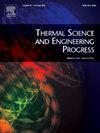Configuration optimization of novel multi-grade waste heat streams coupling and utilization system for enhancing energy efficiency of coking plants
IF 5.4
3区 工程技术
Q2 ENERGY & FUELS
引用次数: 0
Abstract
Recovering waste heat plays a crucial role in enhancing energy efficiency of the coking plants, thereby contributing to the advancement of carbon peak and carbon neutrality. However, overall thermal performance of current coking waste heat recovery processes is relatively low. To solve the problem, three novel systems for coupling and utilizing multi-grade waste heat streams are proposed based on the progressive optimization principle, and they are designated as the ST-AHP-CCP, ST-AHP-CCHP, and ST-AHP-SE-CCHP. The ST-AHP-CCP is used to recover high- and medium-grade waste heat for generating power and producing chilled water at 16°C. To efficiently recover low-grade waste heat, the ST-AHP-CCP is integrated with a heating subsystem, forming the ST-AHP-CCHP. To improve the alignment between energy supply and demand, a hybrid ejector subsystem is integrated into the ST-AHP-CCHP, thus forming the ST-AHP-SE-CCHP. The three proposed systems are analyzed from the perspectives of thermodynamics and economics. The results indicate that overall performance of the ST-AHP-SE-CCHP is the highest among that of the three proposed systems. Thus, the energy conversion and utilization process of the ST-AHP-SE-CCHP is more advanced, and its system configuration is optimal. For the ST-AHP-SE-CCHP, annual utilization rate of waste heat, annual system production exergy efficiency, and payback period are approximately 44.4 %, 67.7 %, and 3.1 years, respectively. If the ST-AHP-SE-CCHP were applied to all coking plants in northern China, it would save approximately 8.67 × 109 Nm3 of natural gas per year and reduce annual carbon emissions by about 1.80 × 107 tons.
新型多级余热流耦合利用系统配置优化,提高焦化厂能效
余热回收对提高焦化厂的能源效率起着至关重要的作用,从而有助于推进碳峰值和碳中和。然而,目前焦化余热回收工艺的整体热性能相对较低。为解决这一问题,基于渐进式优化原理,提出了三种新型多级余热流耦合利用系统,分别命名为ST-AHP-CCP、ST-AHP-CCHP和ST-AHP-SE-CCHP。ST-AHP-CCP用于回收高、中品位废热,用于发电和生产16℃冷冻水。为了有效地回收低品位废热,ST-AHP-CCP与加热子系统集成,形成ST-AHP-CCHP。为了改善能源供需之间的一致性,ST-AHP-CCHP集成了一个混合喷射子系统,从而形成ST-AHP-SE-CCHP。从热力学和经济学的角度对这三种体系进行了分析。结果表明,ST-AHP-SE-CCHP系统的综合性能是三种系统中最高的。因此,ST-AHP-SE-CCHP的能量转换和利用过程更先进,其系统配置是最优的。ST-AHP-SE-CCHP的余热年利用率约为44.4%,系统年生产火用效率约为67.7%,投资回收期约为3.1年。如果将ST-AHP-SE-CCHP应用到中国北方所有焦化厂,每年可节约天然气约8.67 × 109 Nm3,每年可减少碳排放约1.80 × 107吨。
本文章由计算机程序翻译,如有差异,请以英文原文为准。
求助全文
约1分钟内获得全文
求助全文
来源期刊

Thermal Science and Engineering Progress
Chemical Engineering-Fluid Flow and Transfer Processes
CiteScore
7.20
自引率
10.40%
发文量
327
审稿时长
41 days
期刊介绍:
Thermal Science and Engineering Progress (TSEP) publishes original, high-quality research articles that span activities ranging from fundamental scientific research and discussion of the more controversial thermodynamic theories, to developments in thermal engineering that are in many instances examples of the way scientists and engineers are addressing the challenges facing a growing population – smart cities and global warming – maximising thermodynamic efficiencies and minimising all heat losses. It is intended that these will be of current relevance and interest to industry, academia and other practitioners. It is evident that many specialised journals in thermal and, to some extent, in fluid disciplines tend to focus on topics that can be classified as fundamental in nature, or are ‘applied’ and near-market. Thermal Science and Engineering Progress will bridge the gap between these two areas, allowing authors to make an easy choice, should they or a journal editor feel that their papers are ‘out of scope’ when considering other journals. The range of topics covered by Thermal Science and Engineering Progress addresses the rapid rate of development being made in thermal transfer processes as they affect traditional fields, and important growth in the topical research areas of aerospace, thermal biological and medical systems, electronics and nano-technologies, renewable energy systems, food production (including agriculture), and the need to minimise man-made thermal impacts on climate change. Review articles on appropriate topics for TSEP are encouraged, although until TSEP is fully established, these will be limited in number. Before submitting such articles, please contact one of the Editors, or a member of the Editorial Advisory Board with an outline of your proposal and your expertise in the area of your review.
 求助内容:
求助内容: 应助结果提醒方式:
应助结果提醒方式:


